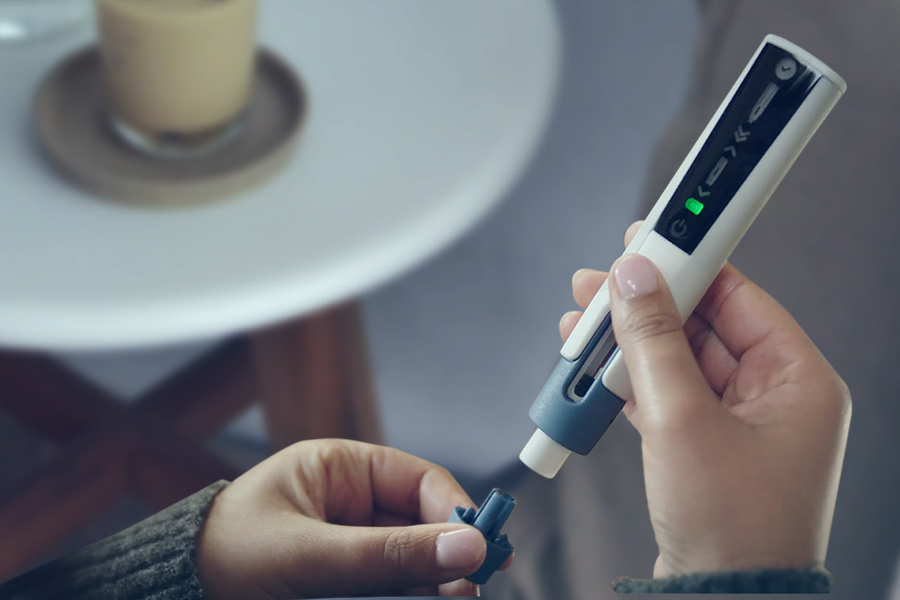Over the past 15 years, autoinjectors have provided an opportunity for product differentiation in several important therapeutic areas. However, as current technology has matured, with issues around ensuring good usability and reliability having been addressed, pharma companies need to identify new needs and appropriate technology to address them. Luckily, for those who want to innovate, emerging requirements ranging from increased sustainability to improved patient support and feedback during device use call for new technology approaches. Additionally, the use of connectivity is beneficial in gathering real-time use data and providing companion digital services and requires the use of electronics. Moreover, there is rising demand to minimize the time, risk and cost of adapting designs for use across broad biologic pharmaceutical portfolios containing multiple drug products with varying viscosities, dose volumes, and injection frequencies.i Phillips-Medisize has illustrated how a new autoinjector design can address these needs by introducing a reusable electronic drive unit and disposable cassette that contains the prefilled syringe and provides needle safety while optimizing the use of new innovator medications, the lifecycle management of existing medications, as well as the introduction of new biosimilar versions of innovator active pharmaceutical ingredients. Increased focus on connectivity is critical, as it enables the application of digital services to medication data to facilitate better patient support, particularly around improving medication adherence.
Connected Health Applications for Autoinjectors
The WHO estimates that patients with chronic conditions have only a 50% adherence rate to medication regimens. Patient outcomes are negatively impacted by non-adherence, which also leads to significant but avoidable increases in the cost of medical care. Estimates of avoidable healthcare costs range up to $290 billion in the US and €125 billion in Europe.ii Pharma companies lose an estimated 36% in potential sales per drug on average.iii This adds up to approximately $188 billion in annual losses for the US pharma industry alone.iv
Patients do not take their medication for a variety of reasons, including symptom intermittence, pharmaceutical efficacy perception, real and perceived side effect concerns, mixed messages about therapies from different clinicians, high out-of-pocket costs, or simply forgetting to take the medication. When patients experience even one unsuccessful injection or doubt whether it was administered correctly, the patient may develop concerns about future injections, which may have detrimental effects on future medication adherence. Because of this, autoinjectors are preferred to syringes,v as they are less prone to user errors and as they hide the needle, can help overcome needle phobia.vi Although mechanical autoinjectors have addressed many possible use errors, they are still susceptible to errors such as lifting the device from the skin before delivery is complete or failure to check the expiration date of the medication. Smart devices can provide better user guidance with audible progress tones throughout the injection, and detection of expired medications in the device, or patient feedback if the device is lifted too soon.
Beyond use errors, medication non-adherence is a behavioral challenge that needs to be addressed using techniques that target factors causing non-adherent behavior. Digital services can provide a cost-effective means of supporting medication adherence, allowing information to be gathered using smartphones and apps, shared between patients, HCPs, and caregivers, and digital interventions to be implemented in a personalized manner.vii Furthermore, the addition of connectivity to a delivery device, such as an autoinjector, can enable reliable and timely monitoring of medication use.
By integrating connectivity into autoinjectors, it is possible to create a hierarchy of healthcare opportunities. At the lowest level, devices can provide an accurate timestamp for when medication was taken, allowing for improved understanding of non-adherence based on quantitative data. However, the situation for a particular patient can be improved only when this information is part of a feedback loop. One route to achieving this is to share the information with a healthcare professional who can identify which patients are struggling with adherence, prioritize those most in need for timely follow-up, and provide support. Patient support programs (PSPs) seek to improve patient engagement and adherence through interventions, such as training or education and they are already common in the pharmaceutical industry.
Digital technologies are starting to be used to improve the efficacy of these programs. Usually, a PSP aims to increase adherence and, as a result, medication sales. However, this business case limits the application of digital technologies to situations where a pharma company can earn an investment return through increased drug sales. Wider use in healthcare is limited to the ability of a healthcare provider under tight time pressure to monitor patient data. Rather than relying on schedule-based support or patients initiating contact, connected health systems can ensure both more efficient use of healthcare resources and better patient service as they can target high-need patients in a timely and proactive way.
Moving up the hierarchy, another possibility is to create a feedback loop in which digital services are used to change patients’ behavior to support adherence. This can be achieved via smartphone apps reminders, medication diaries that allow for monitoring adherence and support. A detailed understanding of the disease, treatment and patient population can enable a richer understanding of the behavioral change interventions that are most likely to be able to improve adherence. A higher level in the hierarchy is the use of digital services to monitor symptoms and clinical outcomes while providing lifestyle interventions that complement medication use. For example, collected usage data can be combined with other data to indicate patient risk of an asthma attack. Alerting the patient may nudge behavior toward improving direct medication usage or seeking medical advice before an attack occurs. Digital services could also target behaviors that support improved outcomes (e.g., exercise, diet). These types of interventions go beyond medication management to focus on disease management. Finally, at the top of the hierarchy is the opportunity to provide personalized healthcare, in which medication use and disease management are tailored to a patient’s specific needs.
Connectivity can be integrated into existing disposable mechanical devices by adding electronic modules that incorporate sensors to detect device use. Although this approach has the benefit of not changing the user interaction, disposal of electronics after a single use has an adverse environmental sustainability impact. Consequently, add-on connectivity has been developed for disposable autoinjectors and other devices, but these have the disadvantage of requiring the user to transfer the add-on module from one disposable device to another. Users may forget to transfer the module to their next device or feel that it is not worth the effort to do so. From an engineering standpoint, ensuring an add-on module can accurately detect and communicate that a patient’s disposable device has been used is more challenging and may result in unreliable monitoring of medication adherence. Reusable delivery devices offer the best of both worlds; the usability of an integrated connectivity solution, combined with the sustainability of reuse, given that the environmental impact is shared across many doses.
__________
i Simpson I, “The New Emerging Needs Driving Autoinjector Development.” ONdrugDelivery, Issue 113 (Oct 2020), pp 20–24
ii Cutler RL, Fernandez-Llimos F, Frommer M, et al. Economic impact of medication non-adherence by disease groups: a systematic review. BMJ Open 2018;8:e016982. doi: 10.1136/bmjopen-2017-016982
iii “IMS Special pharma strategy supplement: Reviving the primary care market,” IMS Health, July 2008 (accessed through Capgemini “Patient Adherence: The Next Frontier in Patient Care.” https://www.capgemini.com/pt-en/resources/patient-adherence-the-next-frontier-in-patient-care/, accessed June 23, 2021.)
iv Capgemini Consulting, HealthPrize Technologies. Estimated Annual Pharmaceutical Revenue Loss Due to Medication Non-Adherence. 2012. https://www.capgemini.com/wp-content/uploads/2017/07/Estimated_Annual_Pharmaceutical_Revenue_Loss_Due_to_Medication_Non-Adherence.pdf, accessed June 23, 2021
v Phillips, J.T., Fox, E., Grainger, W. et al. An open-label, multicenter study to evaluate the safe and effective use of the single-use autoinjector with an Avonex® prefilled syringe in multiple sclerosis subjects. BMC Neurol 11, 126 (2011). https://doi.org/10.1186/1471-2377-11-126
vi https://www.automationworld.com/home/article/21121179/burgeoning-autoinjector-market-demands-flexible-production-options, accessed June 23, 2021
vii Simpson, Iain. Smart Inhalers: The Value and the Challenge, Pharmaceutical Manufacturing and Packing Sourcer, Winter 2020, http://www.samedanltd.com/magazine/15/issue/318/article/5208, accessed June 25, 2021

